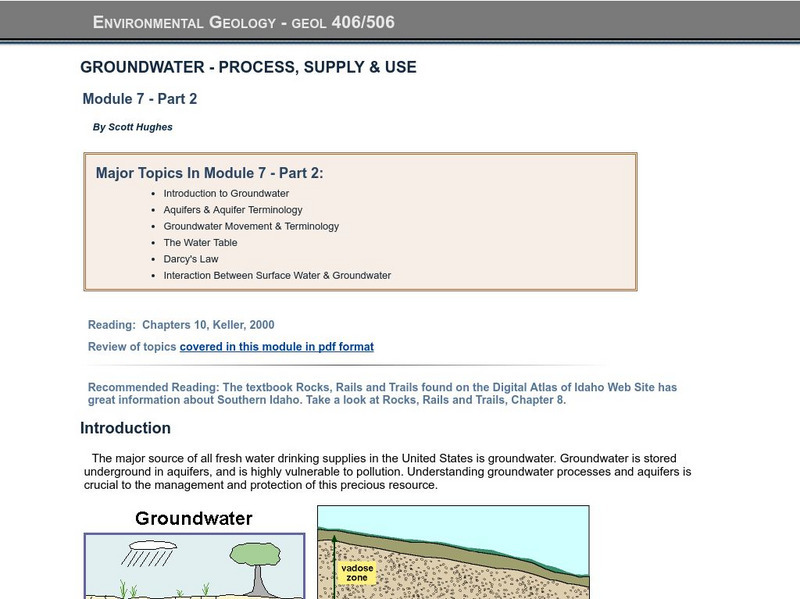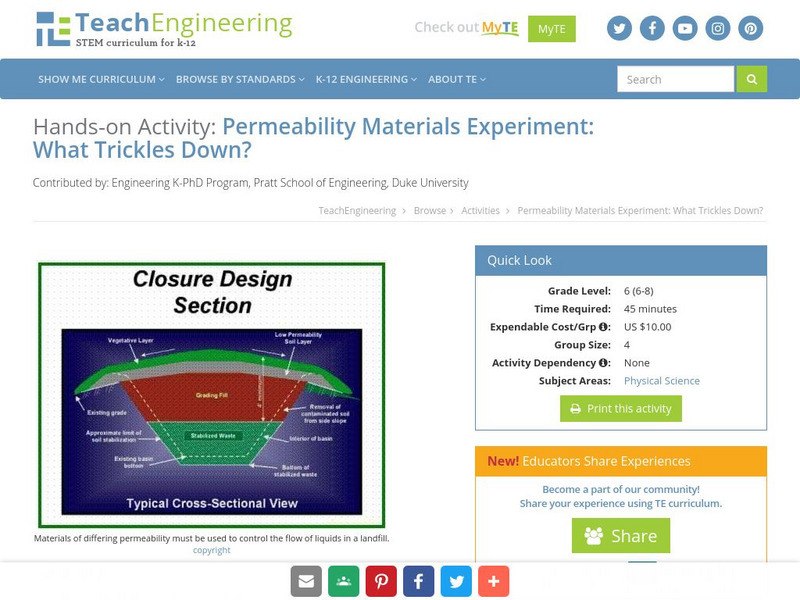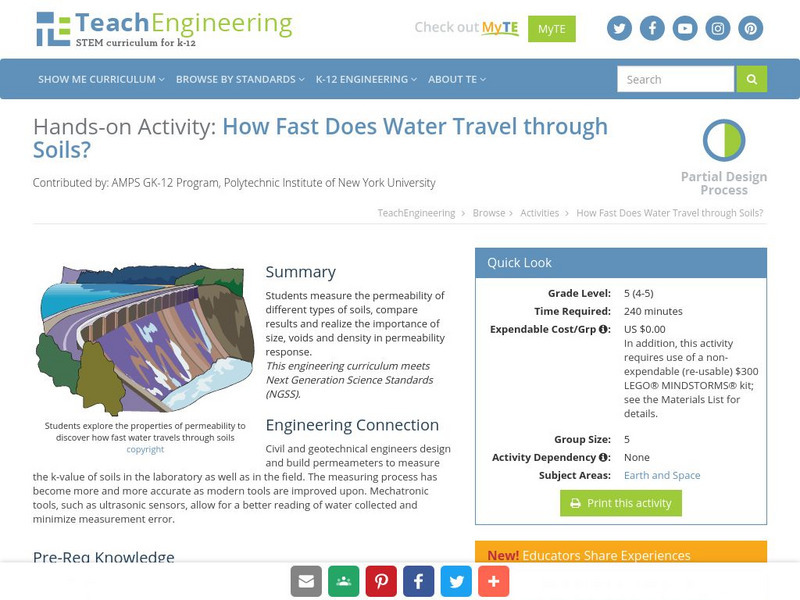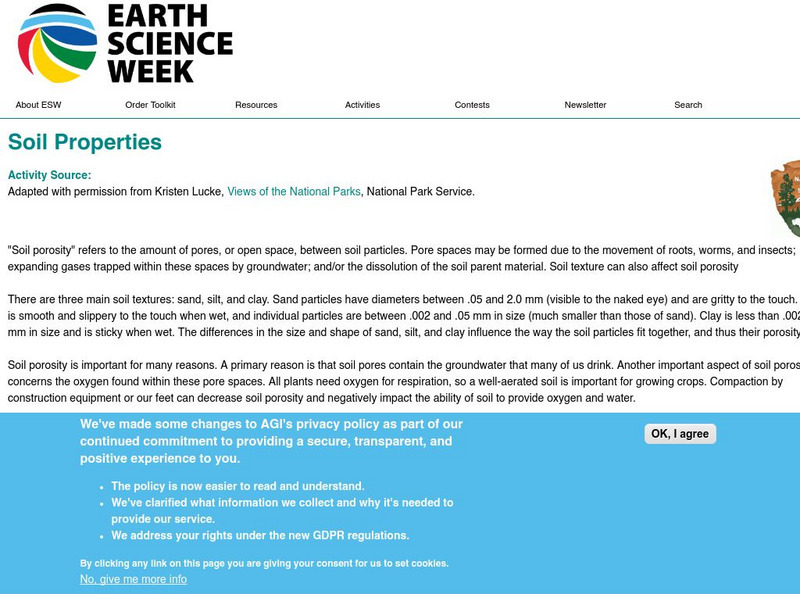Curated OER
Yesterday, Today and Tomorrow -- Oil Recovery Investigation
Students use a model to show primary and secondary oil recovery processes. They discover the effect of rock porosity and permeability on the recovery process. They discuss how to dipose of waste during the process.
Curated OER
Porosity And Permeability
Students participate in an exercise/experiment designed to show how environmental pollution can affect the quality of drinking water.
Curated OER
Oil Search
Students participate in a mock oil search game and attempt to find "oil" in a model oil field. They drill initially based on random guessing, but each time they drill they use prior knowledge to determine where to drill next. They must...
Curated OER
An Underground River
Seventh graders describe how water flows through the ground, what an aquifer is and what soil properties are used to predict groundwater flow. They consider the affects of pollution on groundwater supplies and write a letter drawing...
Curated OER
Our Water Resources
Students build a model aquifer to study groundwater zones and water table formation. Students use the models to measure the movement of polluted groundwater.
Curated OER
Is Your Water Clean?
Students compare water quality of different sources. They test water samples for odor, phosphates, pH, bacteria, and dissolved solids. they fill out a data table and answer questions about their findings.
Curated OER
What's down there?
students analyze how oil is formed and where in the Earth we find it. Students take a core sample to look for oil in a model of the Earth. They analyze their sample and make an informed decision as to whether or not they should "drill...
Curated OER
Earthquake!
Students study causes, probability and location of earthquakes. They complete a number of activities and look at web pages to examine the characteristics of earthquakes.
Curated OER
Wide Open Spaces
Students examine the problem of groundwater pollution. In groups, they develop a solution to solve the problem of a local polluted water source. They also practice measuring the space between sediment particles and the rate of water flow.
Curated OER
Water Flow Through Local Soils
Middle schoolers examine the relationship between particle size and rate of water flow through soil. They collect soil samples, make predictions, conduct a water flow experiment, analyze the data, and answer conclusion questions.
Curated OER
Investigating How Pollutants Travel Through Groundwater
Students determine how pollutants can travel though sediment and explore methods of pollutant removal. They conduct an experiment on porosity and permeability of soils and simulate an EPA "pump and treat" method for removing subsurface...
Energy4Me
Energy4me: Reservoirs and Production
The students will learn that porosity refers to the percentage of holes (pores) in the rock. Permeability is the ability of fluids to travel through porous rocks. If a well is to be successfully produced, the reservoir must have...
Other
Garden With Insight: Porosity
A good description of soil porosity and how it is measured. There are links to mixing soil, aerating soil, and soil settling with rain.
Idaho State University
Idaho State University: Groundwater Process, Supply, and Use
Understand the vulnerability to polltuion the supply of drinking water in the United States has. Know what aquifers are and how groundwater is moved. Identify Darcy's Law and know how to apply it.
Other
Schlumberger Excellence in Education Development: The Permeability of Soil
This resource includes an experiment to show where rainwater goes. Discover the different layers of soil and what each layer is made of.
TeachEngineering
Teach Engineering: The Other Water Cycle
For students that have already been introduced to the water cycle, this instructional activity is intended as a logical follow-up. Students will learn about human impacts on the water cycle that create a pathway for pollutants beginning...
Science Buddies
Science Buddies: Porosity and Particle Size
Often, when we think of something that is solid we think about rocks. But in reality, rocks have tiny holes of air inside them. This is called porosity. In this experiment you can find out what it means to be "solid as a rock."
American Geosciences Institute
American Geosciences Institute: Earth Science Week: Exploring Porosity
Experiment to find out which size of gravel has the most porosity by measuring volume.
TeachEngineering
Teach Engineering: How Full Is Full?
During this activity, students will learn about porosity and permeability and relate these concepts to groundwater flow. Students will use simple materials to conduct a porosity experiment and use the information to understand how...
TeachEngineering
Teach Engineering: What Trickles Down?
Permeability is the degree to which water or other liquids are able to flow through a material. Different substances such as soil, gravel, sand, and asphalt have varying levels of permeability. In this activity, students will explore...
American Geosciences Institute
American Geosciences Institute: Earth Science Week: Measuring Permeabilities of Soil, Sand, and Gravel
This investigation will help students learn that different geologic materials have different characteristics.
TeachEngineering
Teach Engineering: How Fast Does Water Travel Through Soils?
Students measure the permeability of different types of soils, compare results and realize the importance of size, voids and density in permeability response.
American Geosciences Institute
American Geosciences Institute: Earth Science Week: Soil Properties
Students investigate soil porosity by building a model using the three main soil textures: sand, silt, and clay.
Cornell Lab of Ornithology
Habitat Network: Pavement or Gravel
Find out how gravel and pavement can be beneficial to a backyard ecosystem.






















